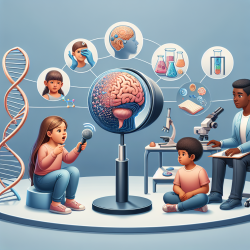Introduction
In the pursuit of optimizing therapeutic outcomes for children, especially those with genetic disorders affecting speech and language, it is crucial to integrate cutting-edge research into practice. The study titled "Essential role of the N-terminal region of TFII-I in viability and behavior" offers valuable insights into the genetic underpinnings of Williams-Beuren Syndrome (WBS), a condition characterized by distinctive cognitive and behavioral phenotypes. This blog aims to translate these findings into actionable strategies for speech-language pathologists (SLPs) and encourage further exploration into the genetic basis of neurodevelopmental disorders.
Understanding the Role of TFII-I
TFII-I is a transcription factor implicated in various developmental processes. The study by Lucena et al. (2010) highlights the significance of the N-terminal region of TFII-I in craniofacial and neurobehavioral development. By examining mutant mice models, the researchers demonstrated that alterations in TFII-I expression lead to phenotypes reminiscent of WBS, including craniofacial abnormalities and heightened anxiety levels.
For SLPs, understanding the genetic contributions to speech and language disorders is crucial. The study underscores the importance of TFII-I in neurocognitive development, suggesting that disruptions in its function could contribute to the speech and language deficits observed in WBS.
Implications for Speech-Language Pathology
Integrating genetic insights into therapeutic practices can enhance the efficacy of interventions for children with WBS and similar disorders. Here are some practical applications:
- Targeted Interventions: Recognizing the role of TFII-I in neurodevelopment can guide SLPs in tailoring interventions that address specific cognitive and behavioral challenges associated with WBS.
- Collaborative Care: Collaborating with geneticists and neurologists can provide a comprehensive understanding of a child's condition, allowing for more personalized therapy plans.
- Continued Research: Encouraging further research into the genetic aspects of speech and language disorders can lead to the development of innovative therapeutic techniques and tools.
Encouraging Further Research
While the study provides significant insights, it also opens avenues for further research. Understanding the specific mechanisms by which TFII-I affects speech and language development can lead to breakthroughs in therapy. SLPs are encouraged to stay abreast of genetic research and consider participating in interdisciplinary studies that explore the genetic basis of neurodevelopmental disorders.
Conclusion
The research on TFII-I and its role in WBS offers a valuable perspective on the genetic factors influencing speech and language development. By integrating these insights into practice, SLPs can enhance their therapeutic approaches and contribute to better outcomes for children with genetic disorders. To delve deeper into the original research, please follow this link: Essential role of the N-terminal region of TFII-I in viability and behavior.










